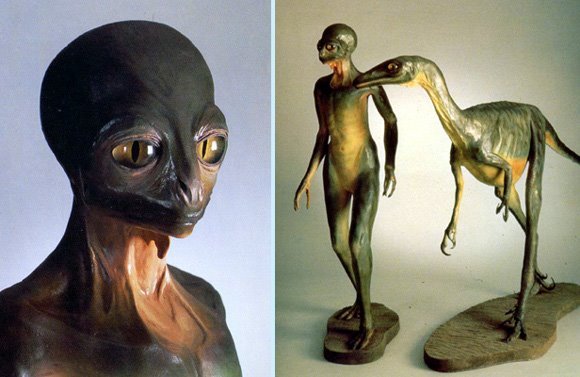The question of why dinosaurs, despite their dominance over the Earth for millions of years, did not evolve in the same way humans did is a fascinating topic. It delves into the differences in evolutionary paths taken by these two groups of organisms.
Understanding why dinosaurs and humans evolved differently sheds light on the broader principles of evolution, natural selection, and adaptation.
Dinosaurs: A Brief Overview
- Types and Diversity of Dinosaurs: Dinosaurs were incredibly diverse, ranging from the massive sauropods like Apatosaurus to the fierce theropods like Tyrannosaurus rex. They occupied a wide variety of ecological niches, from herbivores to apex predators .
- Time Period of Dominance: Dinosaurs dominated the Earth during the Mesozoic Era, which lasted from about 252 to 66 million years ago. They were the dominant terrestrial vertebrates during this time, and their reign lasted for approximately 180 million years .
Human Evolution: A Different Path
- Key Stages in Human Evolution: Human evolution is marked by several key stages, including the development of bipedalism, the use of tools, the development of language, and the expansion of the brain. Species like Australopithecus and Homo habilis were important precursors to modern humans .
- Factors That Influenced Human Evolution: Several factors, including changes in climate, the development of savanna environments, and the ability to adapt to a wide range of habitats, played crucial roles in human evolution. The development of complex social structures and the ability to use tools and fire were also pivotal .
Differences in Environmental Pressures
- Climate and Habitat Differences: Dinosaurs thrived in a relatively stable and warm climate during the Mesozoic Era. In contrast, human ancestors evolved in a world of fluctuating climates, particularly during the Pleistocene, where adapting to colder, more variable environments was crucial .
- Predation and Competition: Dinosaurs faced different predation and competition pressures compared to early humans. Dinosaurs often had to adapt physically to their environment, while humans relied more on cognitive skills and social cooperation to survive and outcompete other species .
Role of Catastrophic Events
- The Impact of the Cretaceous-Paleogene Extinction Event: Approximately 66 million years ago, a catastrophic asteroid impact led to the extinction of most dinosaur species. This event created ecological opportunities that allowed mammals, including the ancestors of humans, to evolve and diversify .
- Survival of Mammals vs. Extinction of Dinosaurs: While most dinosaurs went extinct, small mammals, which were better suited to survive the post-impact environment, began to thrive. These mammals eventually gave rise to primates, the group from which humans evolved .
Differences in Physiology
- Brain Size and Cognitive Development: One of the key differences between dinosaurs and humans is brain size relative to body size. Humans have evolved large brains with advanced cognitive abilities, enabling complex language, problem-solving, and social behaviors. Dinosaurs, while successful in their own right, did not develop similar cognitive capabilities .
- Bipedalism in Humans vs. Dinosaur Locomotion: Humans evolved to walk on two legs (bipedalism), which freed up their hands for tool use and manipulation of the environment. In contrast, while some dinosaurs like Tyrannosaurus rex were bipedal, their adaptations were more focused on hunting and physical dominance than on manipulating the environment .
Ecological Niches and Adaptation
- How Humans Adapted to Changing Environments: Human evolution was heavily influenced by the need to adapt to rapidly changing environments. This led to the development of complex behaviors, social structures, and technologies that allowed humans to survive and thrive in diverse habitats .
- Dinosaurs’ Specialization in Niches: Dinosaurs, on the other hand, were highly specialized to their particular environments. While this specialization made them highly successful during the Mesozoic, it also made them vulnerable to the sudden environmental changes that occurred after the asteroid impact .
Conclusion
- Summary of Key Points: The evolutionary paths of dinosaurs and humans diverged due to a combination of environmental pressures, catastrophic events, and differences in physiology and cognitive development. While dinosaurs were highly successful in their own era, the unique challenges faced by early humans led to the development of intelligence, social structures, and technology that set humans on a different evolutionary path.
- Final Thoughts on Evolutionary Divergence: The story of evolution is one of adaptation and survival in the face of changing conditions. The differences between dinosaurs and humans highlight the diverse ways life can evolve to meet the challenges of the natural world.
References:
- Benton, M. J. (2019). Dinosaurs: New Visions of a Lost World. Thames & Hudson.
- Carroll, S. B. (2005). Endless Forms Most Beautiful: The New Science of Evo Devo. W.W. Norton & Company.
- Brusatte, S. (2018). The Rise and Fall of the Dinosaurs: A New History of a Lost World. HarperCollins.
- Tattersall, I. (2012). Masters of the Planet: The Search for Our Human Origins. Macmillan.
- Zimmer, C. (2014). Evolution: Making Sense of Life. Roberts and Company Publishers.
These references can provide deeper insights into the topics discussed and support the explanations provided in this outline.



